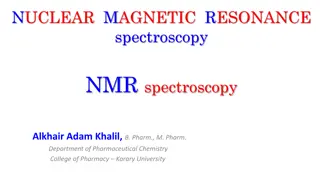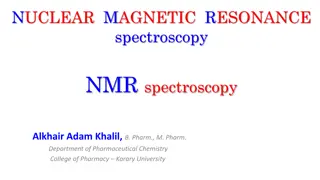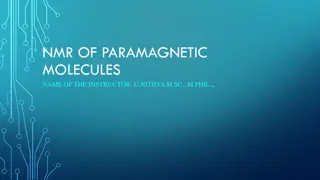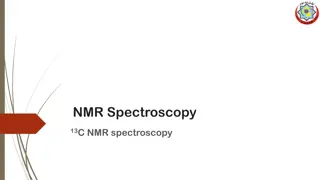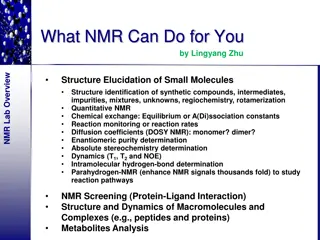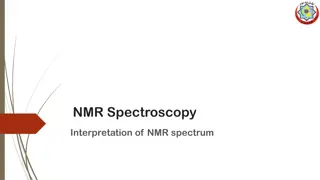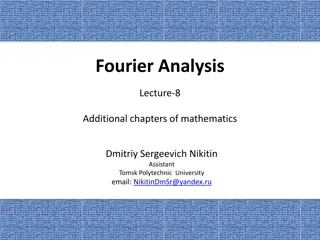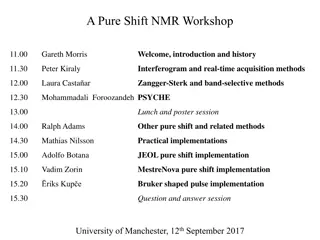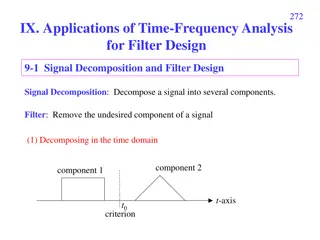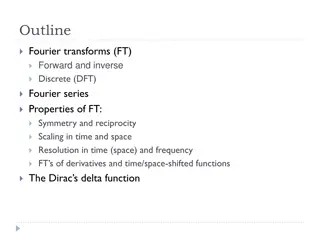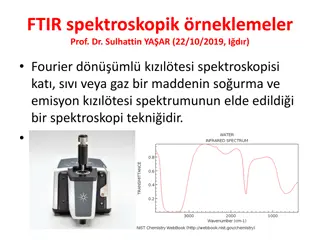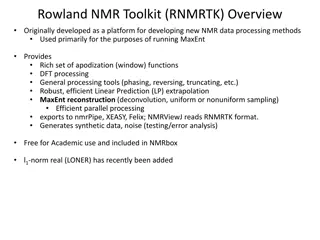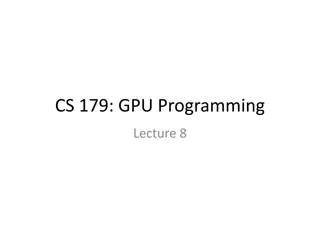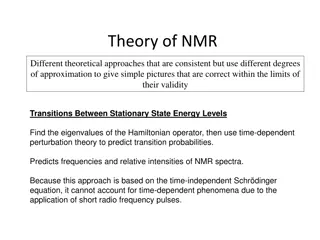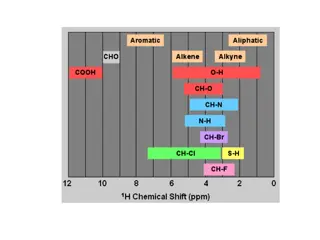Introduction to Fourier-Transform NMR Spectroscopy
This course covers the fundamentals of Fourier-Transform NMR Spectroscopy at a beginner level, progressing to advanced topics in subsequent semesters. Students will gain practical skills in NMR techniques and data interpretation, with a focus on organic and biological molecules.
Download Presentation

Please find below an Image/Link to download the presentation.
The content on the website is provided AS IS for your information and personal use only. It may not be sold, licensed, or shared on other websites without obtaining consent from the author.If you encounter any issues during the download, it is possible that the publisher has removed the file from their server.
You are allowed to download the files provided on this website for personal or commercial use, subject to the condition that they are used lawfully. All files are the property of their respective owners.
The content on the website is provided AS IS for your information and personal use only. It may not be sold, licensed, or shared on other websites without obtaining consent from the author.
E N D
Presentation Transcript
GSU Chem 4050/6050 Lecture 1 Zhenming (Jimmy) Du
Round Robin Instructor: Dr. Zhenming (Jimmy) Du NSC 134A Email: zdu@gsu.edu Phone: 404-413-5538 Website: sites.gsu.edu/zdu Students:
Scope of Chem 4050/6050: Level I Chem 4050/6050. Introduction to Fourier-Transform NMR Spectroscopy. Prerequisites: demonstrated research need and approval of the departmental chair. Introduction to techniques of Fourier-Transform Nuclear Magnetic Resonance Spectroscopy
Next step: Level II Fall Semester Chem 8450, NMR Spectroscopy (4) Prerequisite: Chem 6050 or consent of the instructor. Theory and application of NMR spectroscopy for the characterization and elucidation of organic and biological molecules.
Next step: Level III Spring semester: Chem 8540. Biomolecular Nuclear Magnetic Resonance. (3) Prerequisite: Introductory courses in spectroscopy, such as Chem 4050/6050 and Chem 4190/6190 or equivalent. Some experience in the application of quantum mechanics in spectroscopy is useful, but not essential. Experimental design and interpretation of nuclear magnet resonance data, particulary with respect to applications in structural biology.
Textbook required Edition: 2nd ISBN-13: 978-0198703419 ISBN-10: 0198703414
Helpful Books This text is aimed at people who have some familiarity with high-resolution NMR and who wish to deepen their understanding of how NMR experiments actually work . This revised and updated edition takes the same approach as the highly-acclaimed first edition. The text concentrates on the description of commonly-used experiments and explains in detail the theory behind how such experiments work. The quantum mechanical tools needed to analyse pulse sequences are introduced set by step, but the approach is relatively informal with the emphasis on obtaining a good understanding of how the experiments actually work. The use of two-colour printing and a new larger format improves the readability of the text.
Helpful Books This work-book will guide you safely, in step-by-step descriptions, through every detail of the NMR experiments within, beginning with 1D routine experiments and ending with a series of advanced 3D experiments on a protein:
Topics today NMR Basics: Theory for NMR detection; Concerns during NMR detection. Reading assignment: 1. Lecture 1 notes; 2. Chapter 1 & 2; 3. Read gsuNMR guide before lab 1; 4. Reading NMR operation procedures before lab 1.
1. What is NMR? NMR = Nuclear Magnetic Resonance
About MRI (N)MRI = (Nuclear) Magnetic Resonance Imaging
Protein Structure Illustration 2LCJ CFPGDTRILVQIDGVPQKITLRELYELFED ERYENMVYVRKKPKREIKVYSIDLETGKV VLTDIEDVIKAPATDHLIRFELEDGRSFETT VDHPVLVYENGRFIEKRAFEVKEGDKVL VSELELVEQSSSSQDNPKNENLGSPEHD QLLEIKNIKYVRANDDFVFSLNAKKYHNV IINENIVTHQ Du, Z., Liu, J., Albracht, C.D., Hsu, A., Chen, W., Marieni, M.D., Colelli, K.M., Williams, J.E., Reitter, J.N., Mills, K.V., Wang, C. Journal: (2011) J.Biol.Chem. 286: 38638-38648
Nuclear=? Atoms are made of electrons and nuclei. Each atomic nucleus has four important physical properties: mass, electric charge, magnetism, and spin. Mass, electric charge: more sensible Nuclear magnetism and spin: less tangible ( but need to understand here)
Quantum mechanics treatment Nucleus numbers(n,l,ms,s) have four quantum n: Principle quantum number(n): the size of the orbital (1,2,3, ,n) l: Angular quantum number (l): the shape of the orbital (0, 1, , n-1)(s,p,d,f, ) ms: Magnetic quantum number(m):orientation in space of a particular orbital [-l, ,-2,-1,0,1,2, ,l] s: Nucleus has an intrinsic spin angular momentum ( hence spin quantum number, I).
Nuclear Spin Some nuclei possess an intrinsic angular momentum Nuclear spin angular momentum is quantized in integer multiples of h/2 (or h is Planck s constant) Maximum observable component p of nuclear spin angular momentum is p= I * h/2 I = nuclear spin quantum number I varies as a result of the interactions between protons and neutrons
Nuclear spin differs from electron spin both quantized, I 0: Nmrable
Nuclear spin differs from electron spin both quantized, I 0: Nmrable I Nuclide 0 12C 16O 1/2 1H 13C 15N 19F 29Si, 31P 1 2H 14N 3/2 11B 23Na 35Cl 37Cl 5/2 17O 27Al 3 10B
Example: = * B0/ 2 For proton , = 26.7519 * 107 rad T-1 S-1 For carbon, = 6.73 * 107 rad T-1 S-1 T: Telsa = 10,000 Gauss B0= 9.40T, corresponds to 400MHz NMR for proton. corresponds to NMR for carbon. B0= 11.45T, corresponds to NMR; Bo = , corresponds to 600 MHz NMR; Commercially available magnetic field 1.4T------23.5T 60MHz-1GHz This lies on the radiofrequency range (RF) of the electromagnetic spectrum.
Resonance along is not enough Detecting the resonance is the key!
Low energy range! Radio frequency range!
At room temp, the number of spins in the lower energy level (N+)is slightly greater than the number in the upper level (N-).
The Boltzmann Factor and Partition Functions The Boltzmann factor tells us that if a system has states with energies E1, E2, E3,. , the probability Pj that the system will be in the state with energy Ej depends exponentially on the energy of that state, or Pj ? ??/??? At room temp, the number of spins in the lower energy level (N+)is slightly greater than the number in the upper level (N-).
NMR Detection Key Elements 1. A strong magnetic field; 2. RF pulse to excite nuclei in the sample; 3. Detection of the feedback (NMR signal).
1. A strong magnetic field; Superconduc ting solenoid;
2. RF pulse ? = ? = ?0 Twist between ? and ?0to achieve balance; For protons, if you supply a magnetic field B0, then all protons will appear in the same frequency ? as ??? ??? ??? ??????????.
1926 Paulis prediction of nuclear spin! Two or more identical fermions cannot occupy the same quantum state within a quantum system simultaneously. It is impossible for two electrons to have the same values of the four quantum numbers: n, , angular momentum quantum number, m , the magnetic quantum number, and ms, the spin quantum number.
1932 Detection of nuclear magnetic moment by Stern using molecular beam!
1936 First theoretical prediction of NMR by Gorter; his attempt to detect the first NMR did not work (LiF &K[Al(SO4)2]12H2O) at low temp.
1945 First NMR of solution (Bloch et al for H2O) and solids (Purcell et al for parafin)!
NMR Sensitivity. Relative sensitivity S/N 3 Absolute Sensitivity S/N 3 * C C stands for natural abundance.
Pulse NMR is fast 20ppm at 400MHz= 8000Hz, 125us for 360 pulse 20ppm at 800MHz=16000Hz, 62.5 us for 360 pulse


